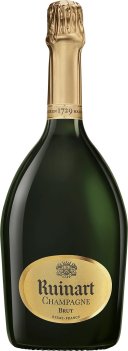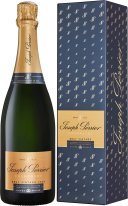Piper-Heidsieck Brut Champagne
Piper is not only one of the world's favourite Champagnes, it's also one of the greatest value-for-money authentic Champagnes available. Created by eight time winner of 'Sparkling Winemaker of the Year' at the International Wine Challenge, Regis Camus, this is a crisp and elegant Champagne with a depth and complexity that belies the price.
Agrapart & Fils 7 Crus Extra-Brut Non-Vintage
Product Information: The NV Brut 7 Crus is a very pretty. Bright, mineral and intensely vibrant, the 7 Crus is full of energy and refreshment. 7 Crus is a blend of two harvests: in this case, 60% is 2021 from 1er Cru sites; and 40% is 2020 from Grand Cru sites. The reserve wine was raised in neutral, 600-litre oak casks from François Chidaine and Didier Dagueneau. The breakdown is 90% Chardonnay and 10% Pinot Noir. Even at this first level, the wine is aged for three years on lees. It was disgorged with 6 g/L dosage. This is the most immediately seductive cuvée in the Agrapart range, yet it is still extremely fine. It’s long, deep and saline with some gentle grip. Sadly, we do not get nearly enough. The reviews below refer to a previous disgorgement. Disg. March 2024. The Agrapart range begins with a non-vintage wine called 7 Crus. The name refers to the seven Côte des Blancs villages from which the wine derives. These include Avize (from younger vines aged 20 to 40 years), Cramant, Oger, Oiry, Avenay-Val-d’Or, Coligny and Vauciennes. Like all Agrapart wines, the fruit is from 100% estate-owned and farmed vineyards. Maker: In 1894 at the beginning of France’s lively Belle Époque “the beautiful era” or Europe's golden era between 1871 to 1914. Arthur Agrapart started the family domaine that would become Champagne Agrapart & Fils. The estate has weathered many storms, including World War I, an economic depression, and the German Occupation during World War II, which devastated stock by millions of cases throughout the region. In the 1950s, Arthur’s grandson Pierre set out to rebuild the family business by making wines of quality rather than following the commercial trends of the day. Pierre’s sons Pascal and Fabrice took over the reins in 1990, farming their own vineyards along the prestigious Côte de Blancs, as well as blending and bottling their own wines. By the early 2000s, upon realising the brothers did not have the same goals for the future of the estate, Pascal began the long-term process of dividing the estate in two. His vineyards would become the backbone of Domaine Pascal Agrapart, focusing on the unique single vineyard cuvées that he had championed since the early 1990s and the remaining family vineyards would provide the fruit for the assemblage cuvées, 7 Crus & Terroirs, still bottled under the Agrapart & Fils label today. Pascal has been joined by his eldest son Ambroise and their ultimate goal is to produce only wines bearing the Pascal Agrapart label. Philosophy: The winery is based in the grand cru village of Avize, famous for its cuvees of 100% Chardonnay. Pascal and Ambroise farm 10 hectares from some 60 different vineyard plots in the Côte de Blancs, including Oger, Cramant, Oiry and Avize. They farm using only homeopathic vine treatments, composts, manures, and regular plowing. The Agraparts were one of the first families to bring the draft horse back to the vineyards, and named a cuvee in honour of their first four-hooved friend, Vénus. In plowing the old-school way, they expose the clay and limestone soils to immune-boosting properties of the wind and sun. While they once were the object of ridicule, they now lead a return to authentic, ancestral practices. Their quality control extends to manual harvests, a selective triage of the grapes, and the use of native yeasts during fermentation. Malolactic fermentations are employed to round out the intensity of these mineral-driven Champagnes. The wines age on their lees for an extended period of time, and then are racked to both stainless steel and neutral oak barrels—the latter being a rarity in Champagne before Pascal started using them. All wines are bottled unfined and unfiltered. Nose - Apricots, Pears, Fennel Vibrant fruit here, with peaches, apricots, lemons, pears, almonds and spicy anise notes. Palate - Intense Minerality, Pillowy Palate, Citrus Peel medium to full-bodied, ample and pillowy palate. Finish - Chalk, Lingering Citrus, Saline White flowers, chalk and citrus linger.
Ruinart R de Ruinart Brut Non-Vintage
The blend is 100% Chardonnay from various years (20 to 25% of which are reserve wines from the 2 previous years). A large majority of Premiers Crus from the Côte des Blancs and Montagne de Reims vineyards for aromatic refinement, supplemented by Sézannais wines known to provide maturity. Finally, several wines from the north of the Vesle valley give a light, fresh touch.
Vranken Demoiselle Parisienne Millesime Champagne
Introducing Vranken Demoiselle Parisienne Millesime 2015, a luxurious champagne that exudes sophistication and elegance, created in 1985. Crafted by the renowned Maison Vranken, this exquisite champagne is a true reflection of the Parisian way of life - refined, chic, and full of joie de vivre. The 2015 vintage is a testament to Vranken's commitment to excellence and the art of champagne-making. Each bottle is a work of art, showcasing the Maison's iconic Parisienne-inspired bottle design and bearing the signature of the Demoiselle herself - a symbol of beauty, grace, and feminine power. As a young entrepreneur, Paul-François Vranken settled in Champagne in 1976 to set up his own champagne house in the heart of the Sézanne region. Then in 1985, he purchased the Château des Castaignes in Montmort, built on the site called La Demoiselle, a few kilometres away from Epernay. The Château is perched on the hillside, in the heart of a park designed by Edouard Redont who also designed the park of Villa Demoiselle. The idea arose to create a new cuvée for Vranken champagne called La Demoiselle de Champagne, Demoiselle being a common name for the dragonfly, which was an emblem for the Art Nouveau genius René Lalique. Everything matched to make this first brut champagne, whose special bottle was a moving tribute to Art Nouveau. In 2004, Paul-François Vranken acquired the Villa Demoiselle to establish the head office of the Champagnes Vranken. Château des Castaignes is therefore the origin of the Demoiselle collection. This romantic champagne comes in a decorated gift box that is a unique and original creation. The shape of the Demoiselle bottles echo the motifs which are found in Art Nouveau, the great artistic movement of the early 20th century, which drew its inspiration from nature. As part of this trend, the Demoiselle cuvée La Parisienne and its opalescent glasswork pays homage to the know-how of the French master glassmaker and jeweller René Lalique. The strong personality of these bottles inspired by Art Nouveau represents the style of Demoiselle's champagne. Pressing of grapes is completed according to the qualitative Champagne pressing principles and the ‘Tête de Cuvée’ specifications. Full traceability of each press is key in order to confirm that the specifications have been adhered to and to record the related technical information. In order to extract the purest juice to provide finesse and elegance, there is a focus on the principle of fractionation: only the first two ‘presses’ of the pressing cycle are used in the ‘Tête de Cuvée’ process, a key element to ensuring quality. Cloaked in the subtlest aromas, the blended juice is higher in sugar and acid content, which lends maturity and freshness to the wines and gives them a remarkable freshness on the palate, apt for ageing. After pressing, in the winery, maximum separation of qualities and crus is ensured in order to have the widest possible range during assemblage. Vraken's teams of oenologists, led by winemaker Dominique Pichart, evaluate each vat during winemaking and select those that are likely to enter the composition of the tête de cuvée. La Parisienne 2015 is a Brut Vintage champagne that comes from the three most classic Champagne grape varieties, with a majority of Chardonnay from Grand cru terroirs. This sparkling champagne is a glowing golden hue with a few green accents complemented by a rich and complex bouquet of ripe fruit, delicate floral notes, and hints of butter brioche and lemongrass. On the palate, Vranken Demoiselle Parisienne Millesime 2015 is a harmonious blend of freshness and intensity, with a silky texture and a long, elegant finish. Its bubbles are delicate and persistent with a very fine strand of foam. It provides a fresh finish and is very balanced on the palate making it an ideal aperitif.
Moët & Chandon Grand Vintage Champagne
Moët & Chandon is arguably the most famous name in the world of Champagne and "Moet" lives up to the hype. Its successful reputation is primarily built on the quality and finesse of its wines, as well as its widespread publicity. The vintage cuvée (based on Pinot Noir fruit) is rich and complex with lovely notes of brioche and almond. Moët Vintage is perfect as an aperitif or surprsingly with many wide and varied food matches.
Moët & Chandon Ice Impérial
Fresh and flavoursome, Moët & Chandon Ice Impérial is perfect for spritzing up a sunny afternoon or adding an elegant tone to any dinner party. Flavours of fresh citrus and stone fruits with ravishing acidity and length.
Billecart-Salmon Brut Rosé
Chamapagne Rosé is a true delight to the senses and Billecart-Salmon rightly takes its place in the top echelon. A vibrant Salmon pink colour greets the glass, with a long, smooth, delicate, elegant and refined palate to follow. Without the price tag that others of this quality demand, this is a Champagne that all must enjoy at least once.
Louis Roederer Vintage Rose
A lively wine with a raisin bread-like note mixed in with the ripe red fruits. Still fresh and vibrant with a clean floral finish. Drink now.
Louis Roederer Brut Vintage
This new vintage is fresh and crisp, taut and racy. A fine youthful wine that promises to age gracefully for five to six years. 70% Pinot noir - 30% Chardonnay. One third of the wine is matured in oak casks prior to bottling, after four years on lees, it is disgorged, it sees dosage of 8-10 g/l before another 6 months in bottle prior to release.
Joseph Perrier Cuvée Royale Vintage
Joseph Perrier Cuvée Royale is one of the standout Champagne's from the 2002 vintage. Conditions in Champagne were simply perfect during the growing and harvest seasons and has resulted in a vintage Champagne with complex bread, toast and honeyed flavours with a long and creamy finish. Divine.
















